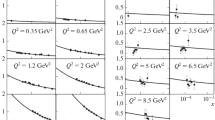Abstract
Many models predict that soft hadron interactions will enter a new regime at the LHC: the creation of a huge energy of hadron collisions due to the S-matrix reaching the unitarity limit [1]. An analysis of the new effects, discovered on the basis of experimental data at 13 TeV [2, 3] and associated with the specific properties of the hadron potential at large distances, is carried out while taking into account experimental data on elastic pp-scattering obtained by the TOTEM and ATLAS collaborations at large hadron collider energies. Quantitative descriptions of all examined experimental data with minimum fitting parameters are obtained. It is shown that peculiarities determined at a high statistical level make an important contribution in differential cross sections and allow one to research the hadron interactions at large distances. The additional (anomalous) term calculated in \(r\) space can be represented by Gaussian form, and the oscillation term can be approximated by the simple Gaussian form.



Similar content being viewed by others
REFERENCES
J. R. Cudell and O. V. Selyugin, “How precisely will the total cross section be measured at the LHC?,” Phys. Rev. Lett. 102, 032003 (2009). arXiv:0812.1892[hep-ph].
O. V. Selyugin, “New feature in the differential cross sections at 13 TeV be measured at the LHC,” Phys. Lett. B 797, 134870 (2019).
O. V. Selyugin, “Anomaly in the differential cross sections at 13 TeV,” Mod. Phys. Lett. A 36, 215148 (2021).
N. N. Bogoliubov and D. V. Shirkov, Quantum Fields (Nauka, Moscow, 1980; Addison-Wesley, 1983).
S. M. Roy, “High energy theorems for strong interactions and their comparison with experimental data,” Phys. Rep. C 5, 125 (1972).
H. Bethe, “Scattering and polarization of protons by nuclei,” Ann. Phys. 3, 190 (1958).
V. A. Petrov, “Coulomb-nuclear interference: the latest modification,” Proc. Steklov Inst. Math. 309, 219 (2020).
O. V. Selyugin, “Coulomb hadron phase factor and spin phenomena in a wide region of transfer momenta,” Phys. Rev. D 61, 074028 (1999).
O. V. Selyugin and O. V. Teryaev, “Generalized parton distributions and description of electromagnetic and graviton form factors of nucleon,” Phys. Rev. D 79, 033003 (2009).
O. V. Selyugin, “GPDs of the nucleons and elastic scattering at high energies,” Eur. Phys. J. C 72, 2073–2076 (2012).
O. V. Selyugin, “Nucleon structure and the high energy interactions,” Phys. Rev. D 91, 11303–11308 (2015).
O. V. Selyugin, “Nucleon structure and spin effects in elastic hadron scattering,” Symmetry 13, 164 (2021).
TOTEM Collab., “Proton-proton elastic scattering at the LHC energy of \(\sqrt s \) = 7 TeV,” Europhys. Lett. 95, 41001 (2011); “Evidence for non-exponential elastic proton-proton differential cross-section at low |t| and \(\sqrt s \) = 8 TeV by TOTEM, Nucl. Phys. B 899, 527 (2015); “Measurement of elastic pp scattering at \(\sqrt s \) = 8 TeV in the Coulomb-nuclear interference region-determination of the ρ-parameter and the total cross-section,” Eur. Phys. J. C 76, 661 (2016); “First determination of the ρ-parameter at \(\sqrt s \) = 13 TeV,” Eur. Phys. J. C 79, 785, 861 (2019).
ATLAS Collab. “Measurement of the total cross section from elastic scattering in pp collisions at \(\sqrt s \) = 7 TeV, Nucl. Phys. B 889, 486 (2014); “Measurement of the total cross section from elastic scattering in pp collisions at \(\sqrt s \) = 8 TeV with ATLAS detector,” Phys. Lett. B 761, 158 (2016); “Measurement of the total cross section and ρ-parameter from elastic scattering in pp collisions at \(\sqrt s \) = 13 TeV with the ATLAS Detector; H. Stenzel et al. (ATLAS Collab.), arXiv:2209.11.487.
A. Anselm and V. Gribov, “Zero pion mass limit in interaction at very high-energies,” Phys. Lett. B 40, 487–493 (1972).
V. Khoze, A. D. Martin, and M. G. Ryskin, “Elastic proton-proton scattering at 13 TeV,” Phys. Rev. D 97, 034019 (2018).
I. M. Sitnik, I. I. Alexeev, and O. V. Selyugin, “The final version of the FUMILIM minimization package,” Comput. Phys. Commun. 251, 107202–107207 (2020).
O. V. Selyugin and J.-R. Cudell, “Long-range potential and the fine structure of the diffraction peak,” AIP Conf. Proc. 1350, 115–118 (2011).
Author information
Authors and Affiliations
Corresponding author
Ethics declarations
The author declares that he has no conflicts of interest.
Rights and permissions
About this article
Cite this article
Selyugin, O.V. Hadron Interaction at Large Distances and New Features of Differential Cross Sections at the Energies of the Large Hadron Collider. Phys. Part. Nuclei Lett. 20, 395–399 (2023). https://doi.org/10.1134/S1547477123030615
Received:
Revised:
Accepted:
Published:
Issue Date:
DOI: https://doi.org/10.1134/S1547477123030615



